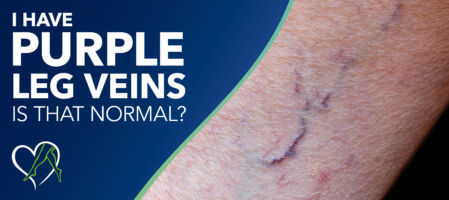
Many people have purple, red, or blue veins on their legs at some point in their lives. And while it's normal to have visible veins on the leg, the color and appearance of these leg veins can be concerning. Is it normal to have dark or colorful leg veins? What do these discolored leg veins signify? How do I make my legs look and feel better? Read to learn the causes of purple leg veins and when to seek medical intervention for this common vascular issue.
Those purple or bluish veins on your legs are typically called varicose veins or spider veins and are a symptom of vein disease. Varicose veins are enlarged, swollen veins that often bulge and twist, appearing as blue or dark purple lines on the skin's surface due to weakened vein walls and faulty valves, leading to blood pooling and vein swelling—a cosmetic concern for some people, and a medical problem for others.
Individuals with varicose veins should look out for symptoms such as pain, heaviness, or swelling in the legs, which could indicate underlying venous insufficiency. Seeking the attention of a qualified vein specialist is crucial to assess the severity of the vein condition and explore appropriate treatment options to prevent potential complications such as blood clots or skin ulcers.
On the other hand, spider veins are usually harmless but can sometimes cause discomfort or itching. These smaller damaged blood vessels beneath the skin's surface can also appear red, blue, or purple, resembling a spider's web or tree branches. Spider veins are typically caused by weakened and expanded small blood vessels under the skin and can cause one to be embarrassed or self-conscious about the appearance of their legs.
It's essential to be aware of the risk factors that cause colorful leg veins so you can seek medical advice. If you experience persistent purple discoloration of your leg veins, it may indicate an underlying issue that requires medical attention.
The risk factors for developing purple leg veins, such as varicose and spider veins, include:
According to Medical News Today, up to 90 percent of people with spider veins have a family history of them. Having one parent with varicose veins increases your likelihood of developing them by 40 percent while having both parents affected raises your risk to as high as 90 percent.
In a study titled “Heritability of Varicose Veins in a Population-Based Twin Study,” the inherited nature of varicose veins is measured by examining data from a large population-based twin study. The researchers found that genetic factors significantly contribute to the development of varicose veins, with a higher risk observed in individuals with affected family members.
Increased blood flow and hormonal changes during pregnancy, including elevated levels of progestin, contribute to the development of varicose veins by placing additional strain on vein valves and widening the veins. Additionally, the expanding uterus adds pressure on lower leg veins, exacerbating the condition and making varicose veins a common occurrence in pregnant women.
Spider veins occur more frequently in females, especially those aged 50 years and older, and the risk increases as the valves in veins weaken over time.
Extra body weight can place added pressure on leg veins, increasing the risk of varicose veins.
Hormonal birth control and treatments for menopause may weaken vein valves, increasing the risk of spider veins.
Remaining in one position for extended periods can lead to weakened vein valves and increased pressure on leg veins, contributing to the development of varicose veins.
Weakened Vein Walls and Valves
Varicose veins are caused by weak vein walls and faulty valves, leading to blood pooling and vein swelling.
It's important to be aware of these risk factors and seek advice from a vein specialist. Also known as a vascular specialist or phlebologist, this vein doctor is specially trained in diagnosing and treating disorders related to the veins, particularly conditions like varicose veins, spider veins, and venous insufficiency.

Persistent purple discoloration of leg veins should be taken seriously as it could indicate underlying venous insufficiency or other vascular issues. Complications of untreated purple leg veins, such as varicose and spider veins, can include:
Persistent discomfort and pain from varicose veins may limit mobility and hinder participation in activities, affecting both physical and emotional health. Seeking timely treatment from a vein specialist can alleviate symptoms and improve the quality of life for individuals affected by varicose veins.
The good news is that several outpatient treatment options are available to manage varicose and spider veins, ranging from lifestyle changes to minimally invasive procedures. These include:
These minimally invasive outpatient procedures, coupled with simple lifestyle changes such as exercising regularly, maintaining a healthy weight, and avoiding prolonged sitting or standing, can help prevent worsening vein problems.
If you have purple leg veins, it's essential to consult with a qualified vein specialist, especially if you experience any accompanying symptoms such as pain, swelling, or discomfort. Your healthcare provider can evaluate your condition, provide a proper diagnosis, and recommend appropriate treatment options tailored to your specific needs. Understanding the causes and treatment options can help you make informed decisions about managing your vein health.
At Center for Vein Restoration (CVR), patients can expect exceptional care from highly experienced and patient-focused doctors. With a commitment to providing personalized treatment plans tailored to individual needs, CVR vein doctors prioritize patient comfort and satisfaction. Their compassionate approach ensures that each patient receives the attention and support necessary for a positive vein treatment experience.
CVR accepts many insurances, including Aetna, Amerigroup, Anthem, Blue Cross/Blue Shield, Cigna, MultiPlan, Medicaid, Medicare, and more.
Call 240-965-3915 to speak to a Patient Services Representative or schedule your consultation online at a CVR near you today.
